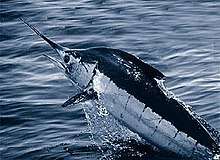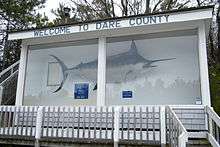Marlin
A marlin is a fish from the family Istiophoridae, which includes about 10 species. It has an elongated body, a spear-like snout or bill, and a long, rigid dorsal fin which extends forward to form a crest. Its common name is thought to derive from its resemblance to a sailor's marlinspike.[1] Marlins are among the fastest marine swimmers, reaching ~36 km/hr (22 mph) in short bursts.[2] However, greatly exaggerated speeds are often claimed in popular literature, based on unreliable or outdated reports.[2]
| Marlin | |
|---|---|
 | |
| Atlantic blue marlin (Makaira nigricans) | |
| Scientific classification | |
| Kingdom: | Animalia |
| Phylum: | Chordata |
| Class: | Actinopterygii |
| Order: | Istiophoriformes |
| Family: | Istiophoridae Rafinesque, 1810 |
| Genera | |
The larger species include the Atlantic blue marlin, Makaira nigricans, which can reach 5 m (16.4 ft) in length and 818 kg (1,803 lb) in weight[3] and the black marlin, Istiompax indica, which can reach in excess of 5 m (16.4 ft) in length and 670 kg (1,480 lb) in weight. They are popular sporting fish in tropical areas. The Atlantic blue marlin and the White marlin are endangered owing to overfishing.[4]
Classification
The marlins are Istiophoriform fish, most closely related to the swordfish,which is the sole member of Xiphiidae. The carangiformes is believed to be the second-closest clade to the Marlins. Although previously thought to be closely related to Scombridae, genetic analysis only shows a slight relationship.
Timeline of genera

In literature

In the Nobel Prize-winning author Ernest Hemingway's 1952 novel The Old Man and the Sea, the central character of the work is an aged Cuban fisherman who, after 84 days without success on the water, heads out to sea to break his run of bad luck. On the 85th day, Santiago, the old fisherman, hooks a resolute marlin; what follows is a great struggle between man, sea creature, and the elements.
Frederick Forsyth's story "The Emperor", in the collection No Comebacks, tells of a bank manager named Murgatroyd, who catches a marlin and is acknowledged by the islanders of Mauritius as a master fisherman.
See also
References
- Douglas Harper (November 2001). "marlin". Online Etymological Dictionary.
- Svendsen, Morten B. S.; Domenici, Paolo; Marras, Stefano; Krause, Jens; Boswell, Kevin M.; Rodriguez-Pinto, Ivan; Wilson, Alexander D. M.; Kurvers, Ralf H. J. M.; Viblanc, Paul E.; Finger, Jean S.; Steffensen, John F. (2016-10-15). "Maximum swimming speeds of sailfish and three other large marine predatory fish species based on muscle contraction time and stride length: a myth revisited". Biology Open. 5 (10): 1415–1419. doi:10.1242/bio.019919. ISSN 2046-6390. PMC 5087677. PMID 27543056.
- "Makaira nigricans, Blue marlin : fisheries, gamefish". FishBase.
- https://ocean.si.edu/ocean-life/fish/tunas-and-marlins-officially-classified-threatened
Further reading
- Froese, Rainer, and Daniel Pauly, eds. (2005). "Istiophoridae" in FishBase. November 2005 version.
- Sepkoski, Jack (2002). "A compendium of fossil marine animal genera". Bulletins of American Paleontology. 364: 560. Archived from the original on 2011-07-23. Retrieved 2011-05-19.
External links
| Wikimedia Commons has media related to Istiophoridae. |
- "'Ghost Fish' Revelation May Alter Marlin's Status" from National Public Radio
- Marlin Fishing from FishingBooker
